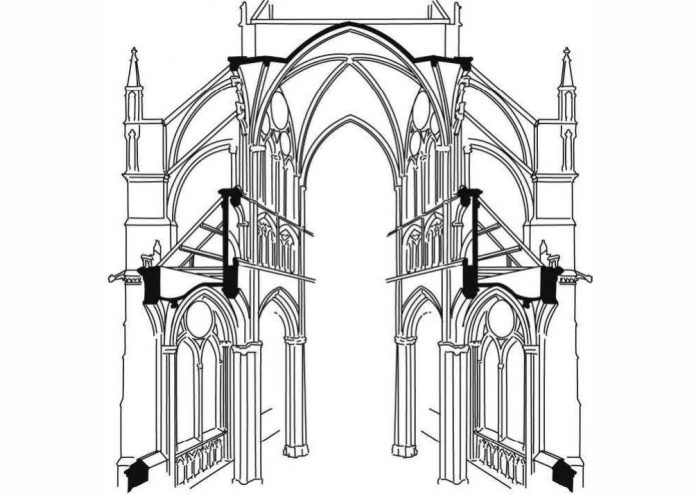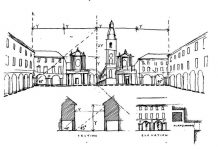In the mid-12th century Abbot Suger of the French abbey of St. Denis commissioned a remodeling of his church. The building was constructed in a new way, with pointed arches, large stained-glass windows, high stone vaults and flying buttresses. So effective was this new style that it spread throughout Europe, dominating Western architecture for more than 300 years. It became known as the Gothic style.
In the 12th century a monk called Suger was elected abbot of his monastery of St. Denis, north of Paris. He decided to rebuild his church, starting at the east end. He gave the building a new choir and seven chapels radiating around the east end, each with two large, glittering stained-glass windows. The pointed arches, stone vaults, flying buttresses and large colorful windows were the key features of a new style of architecture. Soon, Suger’s innovations would be copied all over France and the rest of Europe.
What was the thinking behind Suger’s new way of building? The abbot had a love of brightly colored stained glass, glittering metalwork, jeweled reliquaries and similar objects. For many people, however, such lavish objects of display were inappropriate for a monastery—monks took a vow of poverty, after all. For Suger, though, brightness and light had their roots in Christian theology.
Rooted in the Bible
Suger read deeply in the Bible and the writings of the church fathers. He sought out Old Testament descriptions of the Temple of Solomon, writings by saints and accounts by early churchmen that described the spiritual properties of religious imagery. And he no doubt reread biblical passages, such as the one in St. Paul’s Epistle to the Ephesians, which sees the Christian community as a fellowship with the saints and the household of God himself.
Suger saw his church as an image of God’s kingdom. But how was such a place, pervaded by the presence of God himself, to be imitated on Earth? Suger took his cue from Christian writers who portrayed God in terms of his light. So the book of Revelation describes Heaven in terms of rainbow-like light and crystal and the writings of Dionysius the “pseudo-Areopagite” portray all visible things as lights that reflect the light of God.
Building with light
So the abbot asked for a church flooded with colored light from large stained-glass windows, windows so large that there was virtually no wall left, and so tall that most of the building, from floor to ceiling, was glass. When the new parts of Suger’s church were finished, light flooded into the building from east and west, bathing the whole interior in a brightness unknown in previous churches.
“Bright is that which is brightly coupled with the bright, and bright is the noble edifice which is pervaded by the new light.” Abbot Suger
This stunning effect was achieved with a new system of construction. In the previous generation of churches, the arches had been semicircular, like those of the Romans. But at St. Denis and the other medieval churches that followed it, the arches, the tops of the windows and the vault ribs were pointed. This made them seem to reach upward toward Heaven, a powerful symbolic gesture.
As the medieval masons mastered the new way of building, they designed larger and larger windows and new ways of dividing up each window into a series of panels (known as lights) into which the glazier could insert stained glass. The design of the stonework, often highly intricate, is known as tracery (because the designs were drawn out in chalk on a tracing floor before being transferred to wood templates that the mason could follow). Tracery became more and more elaborate as the Middle Ages progressed.

Pointed arches have a structural benefit, too. With the old semicircular arches, the width of the opening they span is always exactly twice the height, and this makes them very inflexible when it comes to vaulting. Pointed arches, by contrast, can be designed with different width-to-height ratios, which makes it much easier to vault rectangular and irregular spaces.
“Now therefore ye are no more strangers and foreigners, but fellow citizens with the saints, and of the household of God; and are built upon the foundation of the apostles and prophets, Jesus Christ himself being the chief corner stone.” Ephesians 2: 19–20
A stone skeleton
So in Gothic, the stonework becomes an elegant, pointed-arched skeleton made up of pillars, shafts, window mullions and vault ribs. Everything is pointed, and all the molding profiles match so that the entire structure is harmonious. At wall level the spaces between the skeleton are mostly filled with glass; up in the ceiling, the parts between the ribs are filled with stone. The resulting light-filled interior is enclosed in a structure of almost magical airiness.
But there was a problem. A light network of pillars and shafts is not a very good support for a stone-vaulted ceiling. The weight of the stones up above creates an outward thrust, which tends to push the tops of the walls apart and, left to its own devices, would lead to the collapse of the entire building. The inspired invention of flying buttresses dealt with this structural concern.
Flying buttresses
A cross-section of a typical Gothic cathedral shows how the weight of the stone vault and its outward thrust are held in check by the massive masonry of the flying buttresses on the outside of the building. The flying half-arches of each buttress turn the thrust from an outward-pushing force into a vertical one, sending it down, though the mass of masonry, toward the ground. None of this massive structure is visible from the inside of the building, which is dominated by the pointed arches and large windows.
A lasting style
So the combination of spiritual vision and engineering skill combined to make the Gothic churches of the Middle Ages. This new way of building, so successful at St. Denis, spread across France, to England and to the rest of mainland Europe. Masons devised different ways of designing Gothic details, but the style survived, in various modified forms, to the end of the 15th century, and was revived in the 18th and 19th centuries. For many, Abbot Suger’s vision still defines what a church should look like.



















